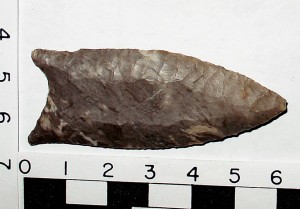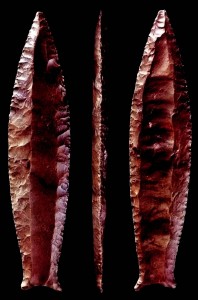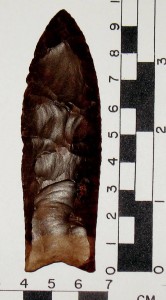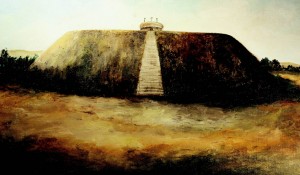The Cumberland phase[15,500-12,500 years before present]is characterized by narrow,lancelate shaped projectile points with constricted hafting zones. The points are normally fully or nearly fully fluted.Unfluted later varients are known as the Beaver Lake type.

Cumberland and related projectile points do not occur over the wide geographical area that characterizes Clovis forms.Most of the Tennessee Valley fluted points are restricted to the Interior Lower Plateau and the surrounding area Dr. Richard M. Gramly has done extensive research on the Cumberland Phase. He refers to this area as the “Shiloh Plateau”which generally stretches from Shiloh, Tennessee east to Pulaski, Tennessee, where a number of Cumberlands have been found.Gramly thinks this was the ideal ecotone which provided deciduous forests and grassy plains for much of the game, while immediately to the North the boreal forests of spruce and jack pines were less attractive for early game and, thus, for Cumberland hunters.As the colder weather began to moderate[14,000-12000 B.P.],this ecotone slowly moved northward.This same environment with the Gulf Stream warm water effect extended up the East Coast, as far north as New England.
By setting up a medium ridge on both sides of a preform the striking platform for fluting must be thick like El Jobo points in Latin America and the cutting edges will be narrow. While thick, narrow fluted spearpoints are useful against large game with tough hydes, Clovis points, thinner and wider instruments with more rounded tips may have been better to cause extensive bleeding. In contrast to the Cumberland, the hafting areas of most Clovises are relatively wide with channel flakes that may not extend very far past halfway.Thus a sleek cutting point capable of deep penetration was created. Since channel flakes were not allowed to extend very far, the tip of the Clovis remained strong as opposed to the more fragile Cumberland.The Cumberland may have been less effective against a greater varity of game than the Clovis. Perhaps the Cumberland fluted points are more specialized for larger game than the Clovis, therefore, probably older rather than younger than Clovis. However, in some cases both Cumberland and Clovises are found on the same sites.
Another argument to support the greater antiquity for Cumberland is their occurance in the earlier ideal ecotone areas. While the Cumberland distribution is rather limited, the Cumberland tradition is not. The Barnes and Folsom point as well as Beaver Lake types occur over a broader area. The author recently designated a new Cumberland varient called “Cloverland”. This type occurs occurs primarily in northern Alabama and southern -middle Tennessee. It’s characterastics are thin like a Clovis and short to medium in length. The basal constriction of Cloverland is wider thaan thje classic Cumberland. There is a thin median ridge quite often taken out by fluting strikes.It has recurvate sides, and is often fluted to the end on on side and only partially on the other side. The Cloverland is probably another late Cumberland varient. Charles E.Moore, Florence,Al. city archaeologist.



